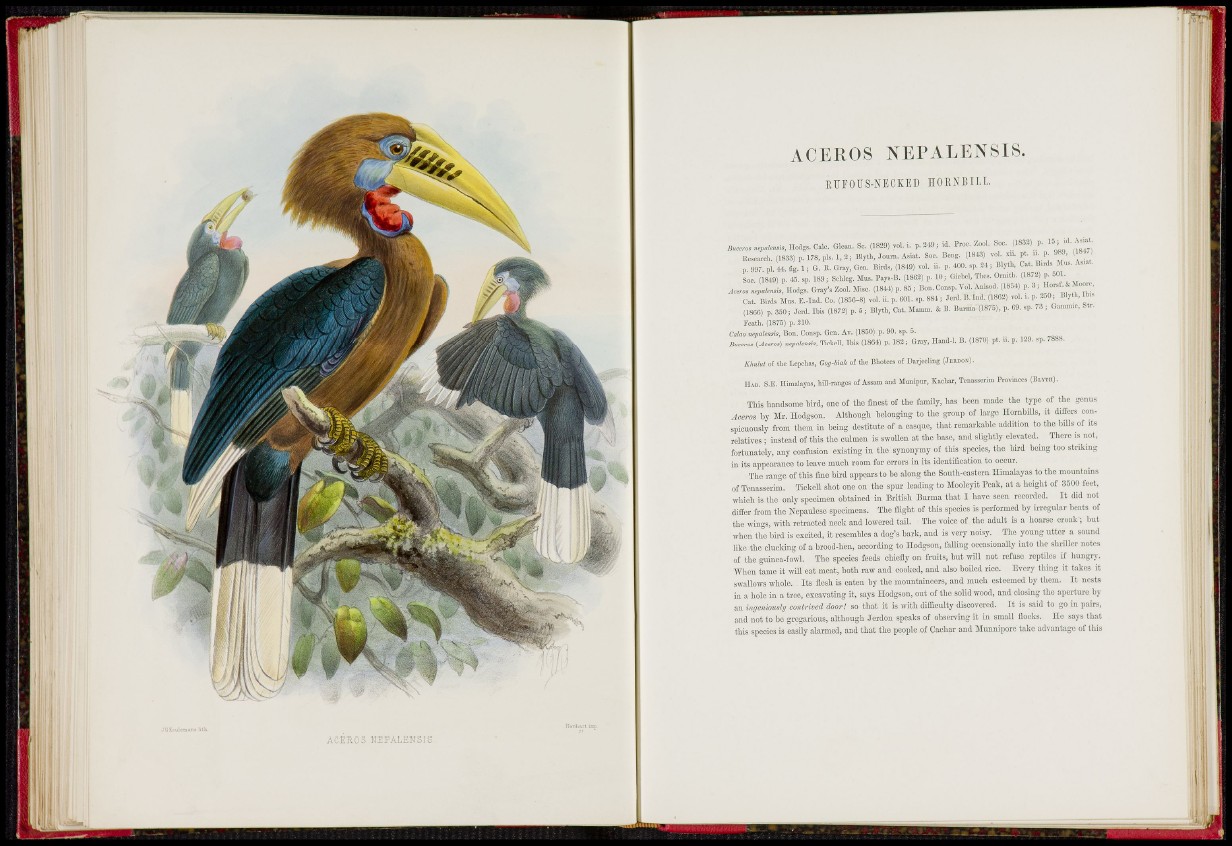
ACEROS BEPALEHSI5
ACEROS NEPALENSIS.
E U F O U S - N E C K E D IIORNBILL
a , »™ Iloclgs. Cfc. Ql™. Sc. (1829) vol. i. p. 2 « ; id. Proc. Zool. S.o. (1832) p. '
II».,•cl. (18S3) p. 178, pb. 1, 2, Bljll,, Jonx». Asi.t. So». Bong. (1813) vol. xii. pt. „. p 9®, d««)
p. 9». pi. -M. 6s. 1. G. E. Gr.,, Oon. Bird., (1819) vol. ii. p. 100. ,p. 2-1; Blfth, Ct. B„d. 5 >». A..«.
Soc. (18.19) p. .p. 189; SoUeg. M™. P.,.-B. (1862) p. 10, Giobol, Tl,o,. Orniih. (1872) j . 60 .
Zool. Miso. (1844) p. 86 , Boo. Con.p. Vol. Anisod. (186.1) p. »i ;
Ct. Birds M™. E.-I..d. Co. (1856-8) vol. ii. p. 601. .p. 881; Jed. B. I,,3. (1862) vol. p. 2o0, 1«;«,. 11»
(1866) p. 3601 lord. Hi. (1872) p. 6 ; Blytli, C.t. Mmm. & B. Bnio. (1876), p. 69. .p- 73 j Gam.uc, btr.
Featli. (1876) p. 210.
afco «.fofc«™, Bon. Comp. Gen. Av. (1860) p. 90. .p. 6.
J!u«,-o, {Aero.) .epakMi,. Tiololi, Ibi. (1864) p. 182; Gr.y, H.ndJ. B. (1870) pi. p. 129. .p. 7888.
Khulul of the Lepclias, Gog-biah oi tlio Bliotoes of Darjoolicg (JEBDON).
11.VB. S.E. Himalaya., hill-ranges of A.sam and Munipur, Kaehar, TcDa.serim Province. (BLVTH).
This handsome hitd, one of the finest of the family, has been made the typo of the genus
AC,TO> by Mr. Hodgson. Althongh belonging to the group of large nornbills, it ditt'ers conspieuously
from them in being destitute of a casque, that remaitable addition to the biHs of its
rektiTes ; instead of this the eulmen is swollen at the base, and sliglitly eleTatod. There is not,
fortunately, any confusion existing in the synonymy of this species, the bird being too striking
in its appearance to leave much room for errors in its identification to occur.
The range of this fine bird appears to be along the South-eastern Himalayas to the mountains
of Tenasserim. TickeU shot one on the spur leadmg to ]Moolejit Peak, at a height of 31300 feet,
»•hich is the only specimen obtained in British Burma that I hate seen recorded. It did not
differ from the Kepaulese specimens. The flight of this species is performed by irregular bents of
tiro wings, with retracted neck and lowered tail. The voice of the adult is a hoarse croak; iiut
when the bird is excited, it resembles a dog's bark, and is very noisy. The young utter a sound
like the clucking of a brood-hen, according to Hodgson, faffing occasionally into the shriller notes
of the gumea-fowh The species feeds chiefly on fruits, but will not refuse reptiles if hungry.
When tame it will eat meat, both raw and cooked, and also boiled rice. Every thing it takes it
swallows whole. Its flesh is eaten by the mountaineers, and much esteemed by them. It nests
in a hole in a tree, excavating it, says Hodgson, out of the solid wood, and closing the aperture by
an higmiomly contrived door! so that it is with difhculty discovered. It is said to go in pairs,
and not to be gregarious, although Jerdon speaks of observing it in small flocks. He says that
this species is easily alarmed, and that the people of Cachar and Slunnipore take advantage of this